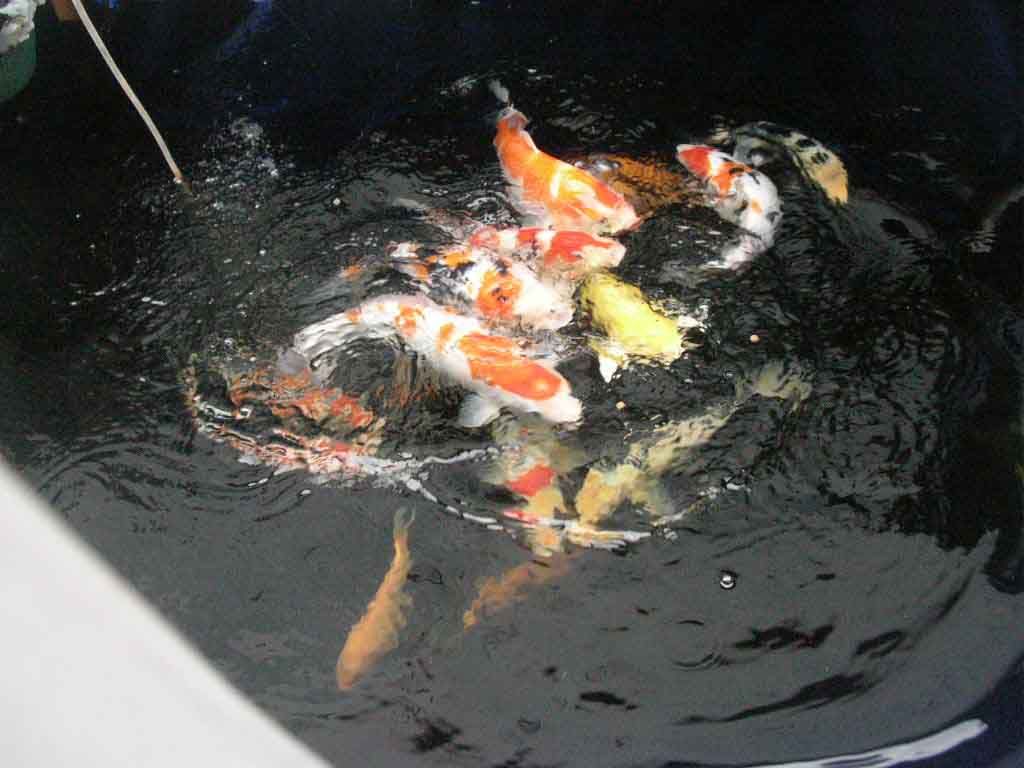The colors on the koi is caused by pigment colors are hidden under the skin of fish.Pigment color will develop if there are foods that support its development. Fish in the wild will obtain natural red, orange and yellow color pigments, via carotenoids, through natural food sources such as shrimps, snails, daphnia and blood worms. Pond's lack these natural food sources so the fish require a supplement to their diets. Unfortunately natural color enhancers are an expensive addition to a diet, so many fish foods do not contain them or they are provided in such small quantities they are not effective.
Carotenoids are a family of over 600 natural lipid-soluble pigments that are produced within microalgae, phytoplankton, and higher plants. They also produce compounds such as essential fatty acids, steroids, sterols, vitamins A, D, E, and K. Within the various classes of natural pigments, the carotenoids are the most widespread and structurally diverse pigmenting agents. They are responsible, in combination with proteins, for many of the brilliant yellow to red colors in plants and the wide range of blue, green, purple, brown and reddish colors of fish and crustaceans.
Carotenoids are absorbed in animal diets - sometimes transformed into other carotenoids, and incorporated into various tissues. As we all know, flamingo's are pink or should be pink - this is due to ingesting algae containing high levels of beta-carotene and then converting this yellow carotenoid into canthaxanthin and astaxanthin before depositing it into the feathers and tissues as red plumage.
Some fish species such as koi and various crustaceans have the enzymatic mechanisms to convert carotenoids into other forms as well, such as astaxanthin - some fish/animals don't. Astaxanthin is the optimal carotenoid for the proper pigmentation of the red/pink colors is aquaria.
Crustaceans and other aquatic animals are unable to produce astaxanthin de novo (naturally), only plants and protists (bacteria, algae, fungi) are capable of synthesizing carotenoids. Therefore astaxanthin must be available in either their native habitat or manufactured diet to meet nutritional requirements. In the natural aquatic environment, astaxanthin is biosynthesized in the food chain within microalgae or phytoplankton at the primary production level. The microalgae are consumed by zooplankton, insects or crustaceans which accumulate astaxanthin, and in turn are ingested by fish which then accrue astaxanthin.
Source:
http://www.canadiankoiandpond.ca/articles/article16.html
Wednesday, December 30, 2015
Subscribe to:
Post Comments (Atom)
Total Pageviews
Labels
KOI POND
Koi Pond Filter
Koi Fish
Koi Care
Koi Type
Koi Clasification
POND FILTER
Koi Equipment
NISHIKIGOI
POND WATER
Kohaku
Aeration Koi Pond
KOI COLOR
Building a koi pond
KOI FOOD
KOI GROWTH
Koi Classification
Koi Pond Design
Koi diseases
Pond Equipment
SANKE
KOI PATERN
Pond Filtration
SHOWA
GOSANKE
Koi Pond Water
Koi Ponds
Koi Treatment
Cheap Koi Pond Filter
DIY Pond Filter
FEEDING KOI
Garden Pond
Goldfish Diseases
Koi Breeding
Koi keeping
OGON
Selecting Koi
Water Pump
Aquatic Plant
BEKKO
BUDO GOROMO
Filter Media
Fish Pond
Fresh Water
Green Water In Koi Pond
KAWARIMONO
Koi Health
Koi Spawning
Koi diet
Koi varieties
Pond Construction
SHOW KOI
Selecting Koi Fish
Veggie Filter
Water Filtration
Water Garden
color enhancing koi foods
water filter
ASAGI
Aeration System
Air Diffuser Aerator
Air pump
Algae Booming
Algae control
Anchor Worm Diseases
Aquatic Pond
Argulus
Asagi Koi
BENIGOI
Backyard Pond
Bakki Shower
Bakki Shower Filter
Best Koi Fish
Bio filter
Biological Filtration
Bog Filter
Bonsai Plant
Bonsai Tree Care
Breeding Koi
Buble diffuser
Building Koi Pond
CHAGOI
CHAMPION KOI
Choosing Koi
Choosing Pond Skimmer
Cleaning A Pond
Clearing Koi Pond Water
Control Algae
Culling Koi
Dechlorinator
Diferent of Male and Female Koi
Doitsu Koi
Filter Chamber
Filter Design
Filter For Small Pond
Floating Plant
Freshwater
GOROMO
German Carp
Ginrin Koi
Goldfish
Goldfish Pond Filtration
Good Koi
Goshiki
Gravity Pond Filter
Gravity Shower Filter
HAIJIRO
HIKARIMONO
HIKARIMOYO
Hikari Mono
Home Made Koi Food
Home Made Pond Filter
How To Build Koi Pond
Ideal Koi Pond
Japan Koi
Japan Koi Show
KARASUGOI
KIGOI
KOI BOOK
KOI FORM
KUMONRYU
Kin Ginrin Koi
Koi
Koi Breeder
Koi Farm
Koi Fish Food
Koi Hobby
Koi Injection
Koi Pattern
Koi Pon Filter
Koi Pond Building
Koi Pond Contruction
Koi Pond Filtration Design
Koi Pond Shape
Koi Quarantine
Koi Show
Koi Stress
Koi evelopment
Koi parasites
Koi tatoos
Landscaping
MATSUBA
Make Koi Body shape
Momotaro Filter
Multichamber Filter
Natural Filter
Nishikigoi breeding
OCHIBA
Ornamental Fish
Overflow system
Oxygenators Water Plant
Pine Core Diseases
Pond Filter Construction
Pond Filter Function
Pond Filters
Pond Lighting
Pond Liner
Pond Liners
Pond Maintenance
Pond Planing
Pond Requirement
Pond Skimmer
Pond aerator
Ponds Plant
Red White Koi
Roto Pond Filter
SORAGOI
Sand Filter
Selecting Asagi Koi
Sexing Koi
Shiro Bekko
Simple Pond Design
TANCHO
Tategoi
Treat Dropsy
Trickle Filter
UTSURIMONO
UV Sterilization
VORTEX CHAMBER
Vegetable Filter
Water Garden Filtration
Water Heater
Water Plant
Water Purifier
Water Quality Parameter
Water treatments
backyard waterfall
barley straw
caring for fish
chromataphores
cleaning pond
determining the quality Koi
garden waterfall
increases dissolved oxygen
koi carp
koi fish breeding
koi fish symbolize
make good koi color
natural biofilter
plant filter
pond design
showa high quality koi care
showa high quality koi information
showa koi fish meaning
waterfall function
waterfall pond





0 comments:
Post a Comment